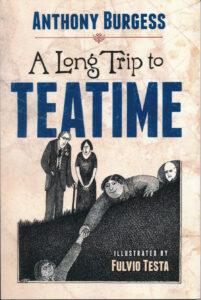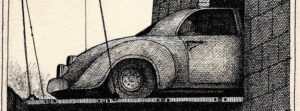A Long Trip to Teatime, or Edgar’s Adventures in Edenborough
In 2015 we celebrated the 150th anniversary of the publication of Lewis Carroll’s Alice’s Adventures in Wonderland (1865). The first tale of Alice’s adventures was followed six years later by Through the Looking-Glass, and What Alice Found There (1871). Both novels proved immediately popular and have continued to inspire readers, writers and artists alike.
Anthony Burgess created his own through-the-looking-glass tale, A Long Trip to Teatime, in 1976, and a draft of this book forms part of the Burgess Foundation’s archive. The novel tells the story of a young boy called Edgar, who, wishing he could escape from a lesson about Anglo-Saxon kings, vanishes through the inkwell in his school desk and has a series of adventures while searching for a route home in time for tea. This was the first of two children’s novels by Burgess, both of which were illustrated by the Italian artist Fulvio Testa.

A Long Trip to Teatime is not merely a fantasy for children. Although Burgess did not write nonsense literature as such, he experimented with several techniques commonly used in the genre in order to subvert ordinary language conventions and logical reasoning. Fantastical words populate the text: ‘There was a load of old rubbish in the corner — bucolics and eclogues and Barclays and sylviuses and economics and bagehots and darwins and ector and kays and seneschals, all very dusty’ — and seemingly logical arguments are extended to illogical conclusions. A snake argues that it is possible to know less than nothing about somebody, because ‘minus one is less than nothing’, and more than everything, since the biggest number there is is ‘about the same as everything’ — ‘And I,’ said the snake, ‘I I I would be able to add one more. And one more. And one more. So, you see, I know more than everything.’
Elsewhere in the novel, reasoning follows a circular pattern that reveals the arbitrariness of its beginning. Posed with a riddle by an all-knowing screen — ‘EXPLAIN HOW IT IS THAT PEOPLE CAN BOTH LIE AND NOT LIE AT THE SAME TIME’ — Edgar answers: ‘King Solomon said that all men are liars, but King Solomon was a man, therefore he was a liar, therefore he was not telling the truth, therefore all men are not liars, but King Solomon was a man, therefore he was not a liar, therefore he was telling the truth when he said that all men are liars, but King Solomon was a man, therefore he was a liar, therefore he was not telling the truth when he said that…’

Burgess also includes puns and word play — a noted astronomer is called Stella Cistern (a pun on ‘stellar system’) — and, like Carroll, uses slang and invents dream-jokes that are difficult, if not impossible, to render in other languages. When asked to give his name, one of the sailors whom Edgar meets says: ‘Boniface, if you’re at all by way of being the least mite interested. Some say as it’s really Bonny Face and others as it’s really Bony Face, but there’s not one bone in my etchy omo as you can see, save for the sniffer perhaps, so I plump for the other meaning.’ Later, an echo is released from a drawer and it calls: ‘Aye aye. I. Eye’.
At times, Burgess appears to quote Carroll directly. When Edgar assumes that the mouse, Albert, is also a prisoner in the castle, Albert replies ‘Stuff and nonsense,’ echoing Alice’s response to the Queen of Hearts. But Burgess does not draw inspiration only from Carroll. He includes verse inspired by the literary nonsense writer, Edward Lear — about whose life he subsequently wrote a film script — and acknowledges a debt to James Joyce. J. S. Atherton points out in his 1977 review that Joyce writes of a ‘hubbub caused in Edenborough’ in Finnegans Wake and Burgess’s Edgar must pass through Edenborough before he can reach teatime. Burgess himself writes in an article titled ‘All About Alice’ (published in the Unesco Courier in June 1982): ‘What, with Carroll, begins as a joke ends, in Joyce, as the most serious attempt ever made to show how the dreaming mind operates.’
When writing A Long Trip to Teatime, Burgess deployed techniques that he had previously used in his novels Nothing Like the Sun (1964) and Napoleon Symphony (1974). Using what he describes in his autobiography as ‘aleatory means’ (the term is taken from musicology), he contrives his plot in part by selecting words from a reference book: many of Edgar’s adventures are associated with ‘E’ and derived by Burgess from the section of a child’s encyclopaedia beginning with that letter. Thus, the novel begins with Edgar being taught by Mr Eadmer about Anglo-Saxon kings such as Edmund Ironside, Edward the Confessor, Edward the Elder and Edward the Martyr. After vanishing down the inkwell, he is put ashore on Easter Island to the sound of Easter bells. And, among the tourists’ guide books in Edenborough, he finds works that describe the statue of Pierce Egan, a miniature El Dorado, a lecture by Ralph Emerson, and the story of the witch of Endor.
In ‘Let’s Talk Nonsense’, an essay on the tradition of nonsense literature, published in the New York Times on 9 August 1987, Burgess writes: ‘The appeal of the Alice books is to the creative imagination, by which space and time can become plastic and language itself diverted from the everyday course of straightforward communication.’ By creating a dream-world in A Long Trip to Teatime, Burgess is playing with language, logic and meaning in a similarly creative way. Yet he is careful to remind us that what occurs in dreams is seldom wholly nonsense:
It is only when, thanks to Albert the mouse, Edgar understands Einstein’s theory of relativity that he can escape from his prison: space and time are relative, just as words in a sentence are modified by each other and the experience of the reader. ‘The nitrogen isotope 14N has a half-life of 5730 years’ is obviously sense, but it is sense that I have to take on trust. I would not dare to say that it is nonsense.


